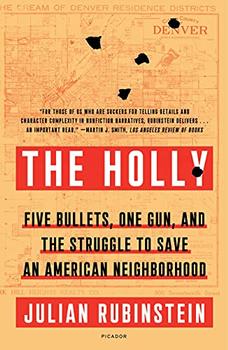Summary | Excerpt | Reviews | Readalikes | Genres & Themes | Author Bio
Five Bullets, One Gun, and the Struggle to Save an American Neighborhood

Critics' Opinion:
Readers' Opinion:
First Published:
May 2021, 400 pages
Paperback:
May 2022, 416 pages
When Ernestine arrived, Five Points' population was about twenty-two thousand. Most of the two-story Victorian-style homes had been divided into apartments. Vacancies were hard to come by. Discriminatory zoning and mortgage-lending practices, known as redlining, prevented Blacks from living in other neighborhoods.
Denver's segregation was rooted in the 1920s, when both the governor, Clarence Morley, and the mayor, Benjamin Stapleton, were members of the KKK. Stapleton served five nonconsecutive terms, more than any other Denver mayor.
"Negroes are holed up in a small area which is getting worse and worse," Mayor Quigg Newton, who defeated Stapleton in 1947, said when he took office. "They are victims of an unwritten law. Sooner or later there must be a breaking through." But, as Ernestine got into a taxi that day, it still hadn't happened.
Ernestine's taxi driver, who also was African American, told her that he'd heard of a place that had a vacancy and took her. It was a two-story, eight-unit building. Ernestine waited on the porch. "Susie?" she heard a woman's voice call. Susie had been Ernestine's childhood nickname in Mississippi. She turned to see her aunt, whom she hadn't seen since her aunt left the South several years earlier, standing at the entrance. She was the building manager.
* * *
FOR $11 A week, Ernestine got her own one-room apartment down the hall from her aunt. She answered a classified ad in The Denver Post to be a cook for a wealthy white family, and was hired, for $20 a day. Soon she had saved enough to buy burial insurance; she wanted to be sure no one in her family would be stuck raising money for her funeral. Then she began making a series of bus trips, back and forth to Arkansas, until she'd brought all nine of her siblings with her to Denver.
In Chicago and Los Angeles, massive public housing complexes such as Cabrini-Green and Jordan Downs were becoming temporary answers to overcrowding in Black neighborhoods. For its part, Denver slowly loosened the boundaries of Five Points. Some of its African American residents moved eastward toward the city's grandest public space, City Park. But the neighborhood that Mayor Newton had singled out for an experiment in "purposeful integration" was on the other side of the park. Allowing Blacks to "jump the park" meant giving them passage to one of Denver's most venerable neighborhoods, Park Hill.
Settled in 1887 by Allois Guillaume Eugene von Winckler, a Prussian baron and soldier, Park Hill had gun violence in its DNA. During the Spanish-American War, von Winckler hosted U.S. Army battalions, who fought mock battles there. A few years later, according to an account in The Denver Times, von Winckler drank enough strychnine to kill six men and shot himself in the chest, a suicide the newspaper called "one of the most remarkable on record."
Von Winckler had begun creating a neighborhood for well-heeled industrialists and statesmen, and after his death, a group of investors who bought the land—including David Gamble, whose family owned Procter and Gamble—were careful about curating Park Hill's development. It had wide boulevards separated by tree-lined medians and featured large Victorian and Tudor homes with carriage houses for the horses. Country living just outside town, according to its marketing.
But one last tract of Park Hill, the far north piece, remained undeveloped until the late 1940s. Denver's new residents then included many military families relocating after the war to Lowry Air Force Base. Some became the first residents of the 2,600 small brick ranch houses that comprised Northeast Park Hill, just a few miles from the base. The neighborhood was also just across Quebec Street from Stapleton International Airport, named for the former mayor.
In 1956, the Federal-Aid Highway Act facilitated construction of the two major interstates that run through Denver, I-70 and I-25. A rapid development of the city's suburbs began. Bigger homes with large backyards went for as little as $20,000. Young military families and other white residents were enticed to move out of the city.
Excerpted from The Holly by Julian Rubinstein. Copyright © 2021 by Julian Rubinstein. Excerpted by permission of Farrar, Straus & Giroux. All rights reserved. No part of this excerpt may be reproduced or reprinted without permission in writing from the publisher.





The Funeral Cryer by Wenyan Lu
Debut novelist Wenyan Lu brings us this witty yet profound story about one woman's midlife reawakening in contemporary rural China.
Your guide toexceptional books
BookBrowse seeks out and recommends the best in contemporary fiction and nonfiction—books that not only engage and entertain but also deepen our understanding of ourselves and the world around us.